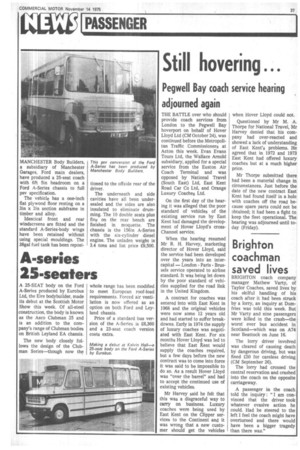Eagle is a flyer
Page 38

Page 39

If you've noticed an error in this article please click here to report it so we can fix it.
by Martin Watkins DRIVING a vehicle worth £42,000 could be a nervewracking experience. But the effortless acceleration, sensitive steering and faultless braking performance of the threeaxle Eagle now being marketed in Britain are enough to pu: your mind at rest.
A turn of the ignition key and a push on the button starter— both among the controls mounted to the right of the driver— brought the 280 horsepower, rear mounted Detroit V8 two stroke diesel purring into life. Second gear engaged easily and on letting off the spring hand-brake, mounted at elbow height on the driver's right, the power was immediate.
Picking a route between the parked coaches at the Bordon, Hampshire, showroom of Baker's, the UK distributors, showed up one slight disadvantage since the wing mirrors are mounted well below the driver's normal sight-line. Although this hardly matters when manoeuvring in confined spaces it can be annoying on the open road.
The ZF six speed gearbox was the first real problem to be faced. I have no doubt at all that the old saying "practice makes perfect" would be quite true applied to the ZF but I never completely mastered the technique during my test drive.
Reverse is spring loaded on the left of the box, fifth and sixth spring loaded on the right, and so finding these three is easy. The snag is that the first to second gate is very close to the third to fourth gate and the driver needs to be spot on to locate them.
The clutch, brake and accel t;.ator pedals are all massive in size but light and precise in operation. The clutch is offset to the left but 'engages smoothly and effortlessly.
Maximum speeds in the gears are about 12mph in second, 30mph in third, 50mph in fourth, and over 70mph in fifth. Sixth gear was too high for normal road work but would be 'ideal for high speed motorway cruising.
Inside the coach the passenger compartment is about 18 in above the floor level of the driver's compartment. This makes the driver very dependent on the wing mirrors for rear visibility as the view through the interior mirror is very restricted.
The ride in the coach is superb, the rubber torsion suspension eliminating all the road bumps. Even at speed on sharply cambered country roads the vehicle never deviated from the desired course—no steering corrcction being necessary at at.
All the body fittings, such as the wing mirrors, wipers, door hinges, catches, etc. are on a massive scale. The only fitting which seemed rather out of keeping with the quality of the coach was the tiny indicator stalk under the steering wheel, worked by the driver's left hand.
A Jacobs exhaust brake is fitted as standard on the coach and gives a claimed maximum retardation of 184 per cent. This is controlled by a small hand on/off switch on the front bulkhead to the right of the driver. It can be left switched on for the whole driving time and only operates' when the driver's foot is taken off the accelerator.
In the low gears the retardation achieved by the exhaust brake is easily sufficient to bring the vehicle virtually to a stop. The Jacobs brake owes its high efficiency to the fact that when applied it shuts both inlet and outlet valves in the cylinder head rather than merely closing a flat over the exhaust pipe.
The coach operator buys a long lasting vehicle for his C42,000. Identical coaches open
ating in the USA are performing scheduled runs of 27,500 miles per month. Clutch life is claimed to be 200,000 miles and brake lining life 100,000 miles.
The passenger also has little cause for complaint. The reclining seats are among the most comfortable I have tried and the ride is excellent and even over the engine at the rear noise levels are very low. The climate inside the coach is kept pleasant by a combined heating, cooling and ventilation system. MANCHESTER Body Builders, a subsidiary of Manchester Garages, Ford main dealers, have produced a 25-seat coach with 6ft 5in headroom on a Ford A-Series chassis to full psv specification.
The vehicle has a one-inch flat plywood floor resting on a 3in x 2in section subframe in timber and alloy.
Identical front and rear windscreens are fitted and the standard A-Series-body wings have been retained without using special mouldings. The 38ga1 fuel tank has been reposi tioned to the offside rear of the driver.
The underneath and side cavities have all been undersealed and the sides are also insulated to eliminate drumming. The 10 double seats plus five on the rear bench are finished in moquette. The chassis is the 156i A-Series with the six-cylinder diesel engine. The unladen weight is 3.4 tons and list price £9,500.




























































































































